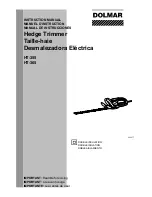
OPERATION
SRM-3020
28
X7502350002
©
2/20
ECHO Incorporated
Scything
Scything - Swing the cutting head in a level arc, gradually feeding the line
into the material being cut. Move forward with each arc to cut a swath. Width
of cutting swath depends on arc. Use a larger arc for a wider swath, or a
smaller arc for a narrow swath. Keep line head tilted to direct cutting debris
forward or away from you.
Operating Techniques
• Debris flows in direction of line head rotation. Change line head position
to assure debris flow is directed away from operator.
• Keep cutting line away from wire fences to avoid entanglement.
• Operate trimmer only with cutting head below knee height.
Reaction Forces
Push or Pull - Kickback or Kickout
During normal use, operating a brushcutter with a circular metal blade can
produce sudden strong reaction forces that are difficult to control. Strong
reaction forces can cause a loss of balance or loss of control of the
equipment, resulting in serious injury to operator and bystanders.
Understanding what causes these reactive forces may help you to avoid
them, and can help you to maintain control of the equipment if you
experience a sudden reaction during cutting. Reactive forces occur when
the force being applied by the cutting teeth of a blade meet resistance, and
some of the cutting force is directed back toward the equipment. The greater
the cutting force or the amount of resistance, the greater the reactive force.
Push and Pull Forces
Push and pull forces are reactive forces that push the
equipment directly toward the operator, or that pull the
equipment directly away from the operator. These forces
are the result of cutting on the sides of the blade. The
direction of the force depends on the side of the blade
being used, and the direction of blade rotation at the point
of contact. The reactive force is in the opposite direction of
blade rotation at the contact point, regardless of where the
contact is being made. These types of reactive forces are
also called “Blade Thrust.
















































